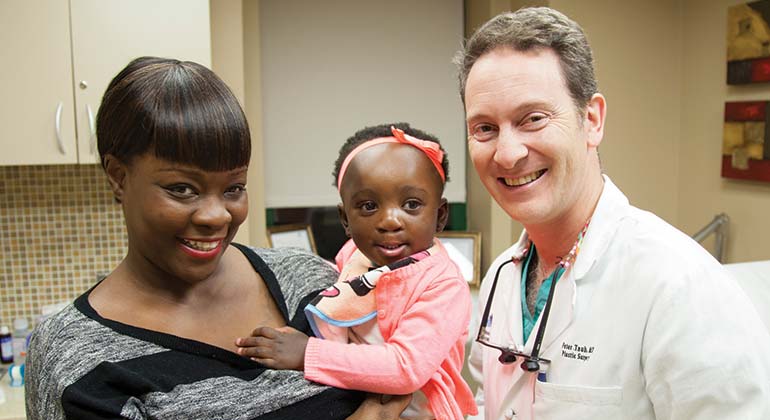Pediatric Plastic Surgery

Plastic surgery can help people look and feel their best. For children, plastic surgeons typically fix deformities caused by birth defects, injury, illness, or tumors. When your child is involved, you want to be sure that he or she is in the best possible hands. You want an experienced and highly trained specialist.
At Mount Sinai, we help children with a variety of needs. We treat everything from the top of the head to the bottom of the foot. And we work with patients from birth to age 21. We strive to give your child the very best individualized care. Our experienced surgeons use the most advanced techniques in the most state-of-the-art facilities.
Conditions We Treat
The most common conditions we treat are:
- Birthmarks: These colored or textured spots on the skin appear at birth or after. Some fade on their own; others may require intervention. This can be medical, procedural and/or surgical.
- Vascular anomalies: These lesions, including hemangiomas, tend to affect the skin and soft tissue. They may appear at birth or sometime after. We may need to perform plastic surgery to restore the contour, symmetry, and function of the tissue. We can start treatment when the child is young, or at a later point.
- Cleft lip or palate: These lip and mouth defects are seen at birth and can make it difficult for the newborn to feed. They may also cause other functional and aesthetic concerns. Generally, we begin to manage these issues when the child is several months old.
- Craniosynostosis: This birth defect happens when the bones of the baby’s skull join together too soon. When the skull cannot grow in one area, it may continue to grow more in another spot, which will lead to a misshapen head. We typically perform a procedure to fix this within the first year of life. Earlier intervention may be required if pressure inside the skull is too high.
- Deformed ears (prominent ears or microtia): Small, absent or prominent ears can affect a child’s appearance and can affect one or both ears. We usually begin surgical correction at age in childhood to avoid social issues.
- Hand anomalies: About 10 percent of babies born with birth defects have malformations of the hand. There are many types of hand anomalies, including extra fingers, missing fingers, fused fingers, club hands, and misshapen thumbs. Typically, we treat these conditions after the child is 6 months old.
- Trauma to hand and face: Injuries to the hand and face are fairly common among young children. While a cast or splint can often be sufficient to help bone injuries heal, others may require surgery.
- Malocclusion of the jaws: This condition occurs when there is a mismatch between the sizes of the upper and lower jaw. We may need to perform surgery if the infant is having breathing or feeding problems. More often, this is managed later with braces and jaw surgery.
The Process
Generally, patients come to our office through a referral. Most referrals come from pediatricians, pediatric general surgeons, or pediatric neurologists, though we work with a wide range of departments. Typically, we start with a consultation, either in the hospital or in the office. Before a procedure, we may do imaging tests or blood work, depending on the condition.
Procedures can be inpatient or outpatient. We operate at Kravis Children’s Hospital at Mount Sinai Hospital, Mount Sinai West, and Mount Sinai St. Luke’s. Some patients spend a night or two in the hospital after the procedure; others can go home the same day, depending on the medical condition and procedure.
Our expert health care providers function as a team to meet your needs. We often work with dermatologists, pediatricians, psychologists, social workers, and other health care professionals. At Mount Sinai, your child’s privacy and well-being are very important to us.
Our highly trained pediatric plastic surgeons serve under the direction of Peter J. Taub, MD, MS, Chief of Pediatric Plastic Surgery at the Kravis Children’s Hospital at Mount Sinai and Director of the Birthmarks and Vascular Anomalies Program and Co-Director of the Cleft and Craniofacial Center. Dr. Taub is a Fellow of both the American College of Surgeons and the American Academy of Pediatrics. He has served as President of the American Academy of Pediatrics Section on Plastic Surgery and the American Association of Pediatric Plastic Surgeons, as well as numerous other academic societies. He has authored chapters in seminal textbooks on pediatric plastic surgery and has published numerous abstracts.
Our History in Pediatric Plastic Surgery
The Division’s founder, Arthur J. Barsky, MD, was a pioneer in pediatric plastic surgery. He provided care in the United States, Vietnam, and many other countries around the world. Dr. Barsky created the first comprehensive cleft lip/palate and craniofacial program in the New York area. Mount Sinai has a long history of excellence in pediatric plastic surgery.
Meet Our Team
Our surgeons have fellowship training specifically in pediatric plastic surgery, and are board certified by the American Board of Plastic Surgery, the only board recognized by the American Board of Medical Specialties to certify plastic surgeons. They are full-time professors at the Icahn School of Medicine at Mount Sinai.